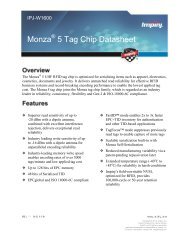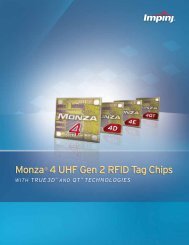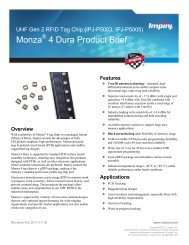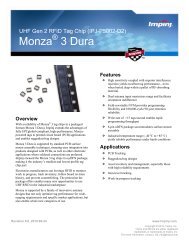Indy R1000 Datasheet - Impinj
Indy R1000 Datasheet - Impinj
Indy R1000 Datasheet - Impinj
Create successful ePaper yourself
Turn your PDF publications into a flip-book with our unique Google optimized e-Paper software.
<strong>Indy</strong> <strong>R1000</strong> ® Electrical, Mechanical, & Thermal Specification<br />
5 Functional Description<br />
The transmitter supports both in-phase quadrature (I-Q) vector modulation and polar modulation. The direct IQ up-conversion is intended for single<br />
sideband amplitude shift keying (SSB-ASK) and phase reversal amplitude shift keying (PR-ASK). The polar modulation is intended for double<br />
sideband amplitude shift keying (DSB-ASK). In both cases, the signals are generated in the digital domain and converted to analog signals by sigmadelta<br />
digital-to-analog converters followed by reconstruction filters. The integrated PA can be operated in three different modes:<br />
• Class F with high output power and without internal amplitude modulation (AM)<br />
The PA acts as a driver for an external PA. The AM is performed in the external PA, but it does require an external modulator.<br />
• Class A required for SSB-ASK and PR-ASK<br />
An optional linear external PA can be fitted to increase the output power to the maximum allowed level.<br />
The baseband encoding and pulse-shaping is done with a lookup table to minimize latency. In the case of SSB-ASK transmission, the baseband<br />
signal is filtered with a Hilbert filter to create a complex IQ signal with suppressed negative frequencies. The signal is then offset in frequency to<br />
center the SSB-ASK spectrum in the channel. The digital I and Q signals are converted into the analog domain by sigma-delta DACs.<br />
In DSB-ASK transmission, the baseband encoding and pulse shaping is performed in the same manner as it was for SSB-ASK, but the shaped signal<br />
is pre-distorted to compensate for non-linearity in the AM transfer function. The pre-distorted AM control signal is converted into the analog domain<br />
by the I and Q sigma-delta DACs as defined in the lookup tables.<br />
The receiver is in principle a homodyne to ensure that as much as possible of the transmitter (TX) leakage falls on DC. The receiver downconversion<br />
mixer can be driven either by the internal local oscillator (LO) signal or by an external LO signal typically tapped off from the output of the external<br />
PA. The receiver uses a single on chip low noise amplifier (LNA). If the system needs to accommodate a +10-dBm jammer, a 4-dB external<br />
attenuator is required.<br />
After downconversion, the major part of the DC is removed by resettable AC-coupling capacitors. The analog intermediate frequency (IF) filter<br />
provides coarse channel selectivity. It has programmable bandwidth to accommodate for the large range of required data rates. The coarsely filtered I<br />
and Q signals are analog-to-digital converted. Automatic IF gain stepping in the filter reduces the required dynamic range of the ADC. Sharp and<br />
well controlled digital filtering supplements the coarse analog filtering. The demodulation is also performed digitally.<br />
The clocks for the digital blocks are derived from a 24-MHz reference frequency originating from an external temperature compensated crystal<br />
oscillator (TCXO). The sigma-delta DACs run directly on the 24-MHz signal. The sigma-delta ADCs run on a 48-MHz clock generated by an<br />
integrated frequency doubler.<br />
The VCO is fully integrated. The loop filter is external for the synthesizer to meet the stringent phase noise requirements. The time reference<br />
required by the phase locked loop (PLL) and the digital blocks is derived from the 24-MHz reference frequency.<br />
The <strong>Indy</strong> <strong>R1000</strong> reader chip supports two interfaces, one low speed parallel interface with a data rate of up to 20 Mbps, and one serial interface with<br />
a data rate of 150 Mbps to the <strong>Indy</strong> <strong>R1000</strong> reader chip and up to 450 Mbps from the <strong>Indy</strong> <strong>R1000</strong> reader chip. The interfaces are multiplexed on the<br />
same pins, and the interface is determined during power-up. Both interfaces are operated at 3.3 V. Low level instructions are written into a first in,<br />
first out (FIFO) buffer and executed one at a time by the <strong>Indy</strong> <strong>R1000</strong> reader chip. All information is transferred via the register bank. The control of<br />
the <strong>Indy</strong> <strong>R1000</strong> reader chip is state machine driven.<br />
14 Revision 2.3, Copyright © 2012, <strong>Impinj</strong>, Inc.







